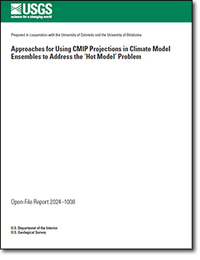Approaches for Using CMIP Projections in Climate Model Ensembles to Address the ‘Hot Model’ Problem
Links
- Document: Report (820 KB pdf) , HTML , XML
- Download citation as: RIS | Dublin Core
Abstract
Several recent generation global-climate models were found to have anomalously high climate sensitivities and may not be useful for certain applications. Four approaches for developing ensembles of climate projections for applications that address this issue are:
- Using an “all models” approach;
- Screening using equilibrium climate sensitivity and (or) transient climate response;
- Bayesian model averaging; and
- Using global warming levels.
Advantages and disadvantages of each approach are described by using example applications to study the effects of climate change on an imaginary at-risk species. Choosing the right approach is dependent on the location, goals, and system focus of each application and the risk-tolerance and resource-management context.
Suggested Citation
Boyles, R., Nikiel, C.A., Miller, B.W., Littell, J., Terando, A.J., Rangwala, I., Alder, J.R., Rosendahl, D.H., and Wootten, A.M., 2024, Approaches for using CMIP projections in climate model ensembles to address the ‘hot model’ problem: U.S. Geological Survey Open-File Report 2024–1008, 14 p., https://doi.org/10.3133/ofr20241008
ISSN: 2331-1258 (online)
Table of Contents
- Acknowledgements
- Abstract
- Introduction
- Approaches for GCM Selection and Weighting
- Example: The Golden-billed Raptor
- Conclusion
- References Cited
- Glossary
- Appendix 1
| Publication type | Report |
|---|---|
| Publication Subtype | USGS Numbered Series |
| Title | Approaches for using CMIP projections in climate model ensembles to address the ‘hot model’ problem |
| Series title | Open-File Report |
| Series number | 2024-1008 |
| DOI | 10.3133/ofr20241008 |
| Publication Date | February 07, 2024 |
| Year Published | 2024 |
| Language | English |
| Publisher | U.S. Geological Survey |
| Publisher location | Reston, VA |
| Contributing office(s) | Alaska Science Center, Southeast Climate Science Center, National Climate Adaptation Science Center, South Central Climate Adaptation Science Center |
| Description | v, 14 p. |
| Online Only (Y/N) | Y |
| Additional Online Files (Y/N) | N |


